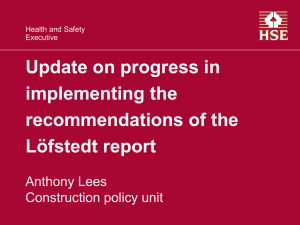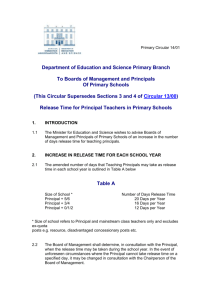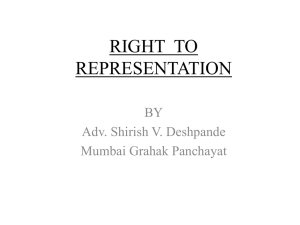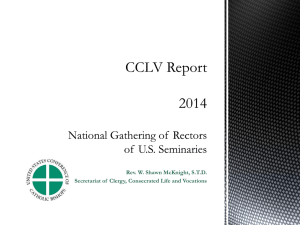Bill Noble Units Allocations
advertisement
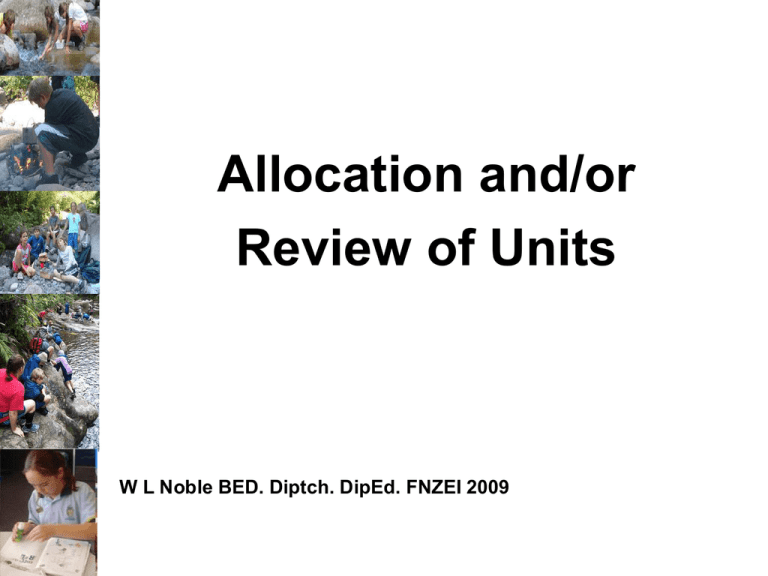
Allocation and/or Review of Units W L Noble BED. Diptch. DipEd. FNZEI 2009 The allocation of units can be very stressful for principals. There are three points of view around units: • There are not enough. • There are too many. • I wish we didn’t have them. It is hoped that this presentation might make it easier. History of Units Units are a carry over from pay parity. Senior Teacher positions were changed from a Senior Teacher’s salary to a unit payment. This created the opportunity to pay teachers one or more units to carry out specific tasks and or responsibilities. Since pay parity NZEI has tried to gain unit parity with the PPTA. With the latest increase of unit numbers parity with units with the PPTA has nearly been achieved. It must be realised that in negotiations and a directive from the membership that units were to be used firstly to develop a career structure. Process Firstly there MUST be consultation with teaching staff. The best way to start this consultation is to use the guidelines developed jointly by NZEI, MoE and NZSTA. A suggestion is that these be given to teachers in syndicates or small groups of teachers to have a discussion about how they think units should be used and allocated. Units give the Principal an opportunity to rethink career paths for teachers and additional leadership roles within a school. Units and Career Paths • Additional teaching and learning responsibilities. • Based on the needs of the school. • Developing a career pathways, roles and responsibilities. • A key element in the allocation process is a clear job description this should apply to both fix term and permanent units. • Exciting initiatives/opportunities. • A mixture of fixed/permanent term units (important). Permanent Units • The Primary Teachers' Contract requires an minimum of % units 60 must be allocated as permanent. • These units are the traditional senior and middle management positions. • Permanent units cannot be taken away from teachers who hold them. • As a guide from limited research it has the following break down has shown 46% Senior Management, 27% Middle Management, 27% Curriculum and recruitment and retention. Key Principles • The units allocation supports a logical and transparent career structure within the school. • Units are allocated, and new roles created, on the basis of the different needs of the school. • Units are allocated to provide recognition and reward for leadership, teaching and learning, not simply work load. • Allocation of units is based on objective criteria, i.e. to be positions rather than to specific people holding positions. • The teaching staff are consulted about the development or review of the unit allocation policy. • The requirements of the PTCA are met. Overview Questions • What career structure does the school have now? • What career structure could the school have to support its strategic direction? • How will the units be used to create that structure? • How will existing unit allocations and career structures be development to achieve that structure? • How will the transition process be organised? • Questions to Facilitate Thinking and Discussion. These are on page 5 of the document Unit Allocation Guidelines. These need to be run off for all teachers to discuss. Developing Policy Key guiding principals • The priorities that have been determined for the allocation of both fixed term and permanent units. • The roles and responsibilities that will have units attached and the transition of those roles. • The balance between permanent and fixed term units. • The process for appointing people to those positions. • The process to be followed when the fix term expires. • How changes will be dealt with, e.g., staff changes, reduced or increased unit allocation. Board Delegation to the Principal It could be useful for the Principal to present the following information to the Board/staff. • A briefing on what units are and the purpose of the units. • The current school policy on unit allocation. • Where applicable the increase of decrease of units. • How and when consultation with teaching staff will occur. Consultation with Teachers The intended consultation process, include how this will occur: • The school’s current unit allocation policy. • Relevant information about units and career pathways that teachers need in order to constructively participation in the consultation (Principals need to be quite explicit here because many teachers don’t see the need to increase the DP units). • The process for confirming the final decision on the school’s unit allocation policy (Principals also need to make it quite clear consultation means consultation it does not mean agreement the principal might have to have the final say). Reviewing the Policy The process that has been outlined can be used whenever the unit policy needs reviewing particularly in the situation of a falling role. Triggers that could cause a review: • • • • Staff turnover. Recruitment/retention issues. New educational initiatives. Changes to the school’s unit entitlement. Acknowledgements/Comments NZEI, MoE and NZSTA joint Unit Allocation Guidelines • This can be found on the NZEI Website. • If this presentation is going to be used the presenter should read the guidelines and have copies of the Principles of Consultation for all Principals.


